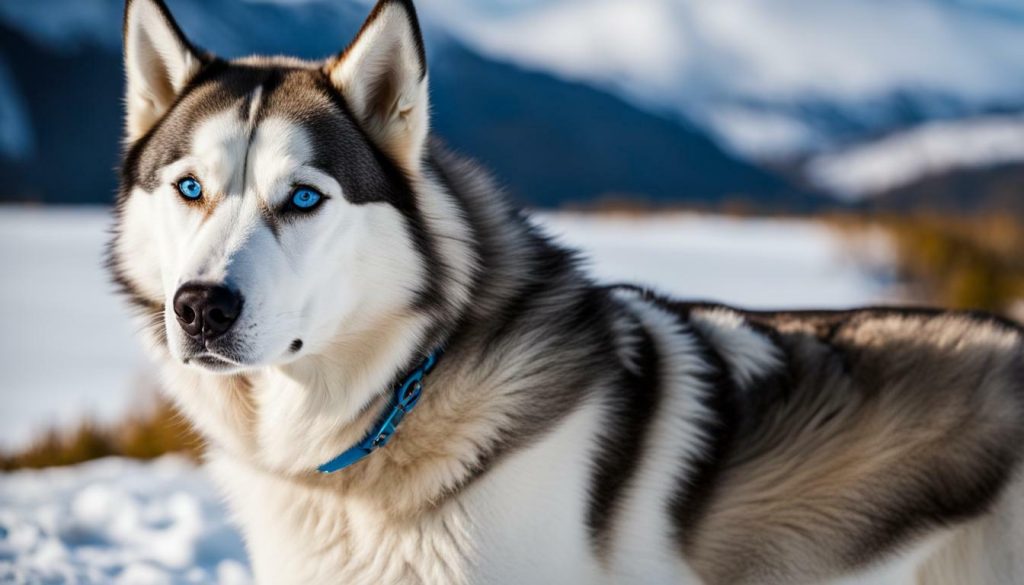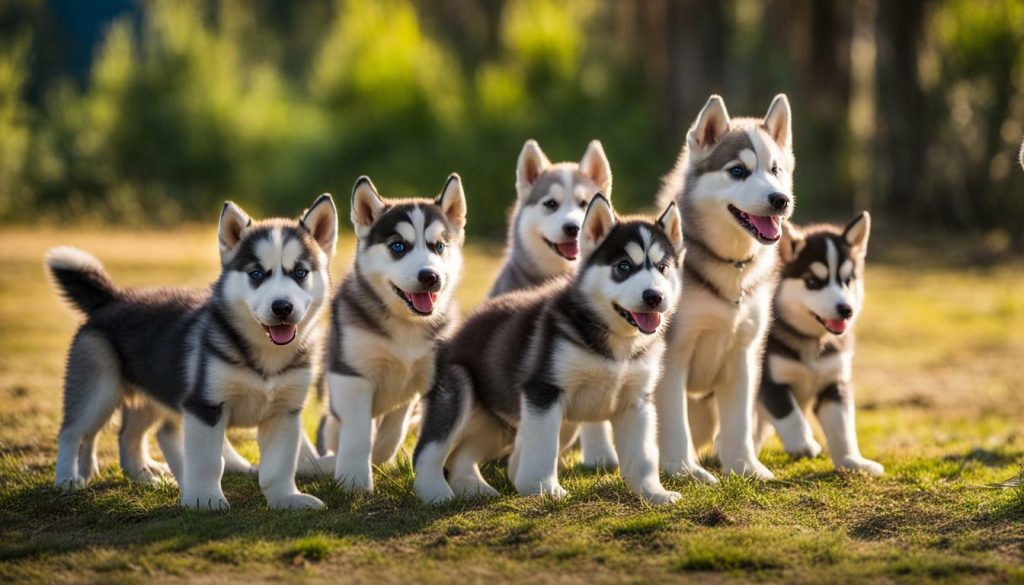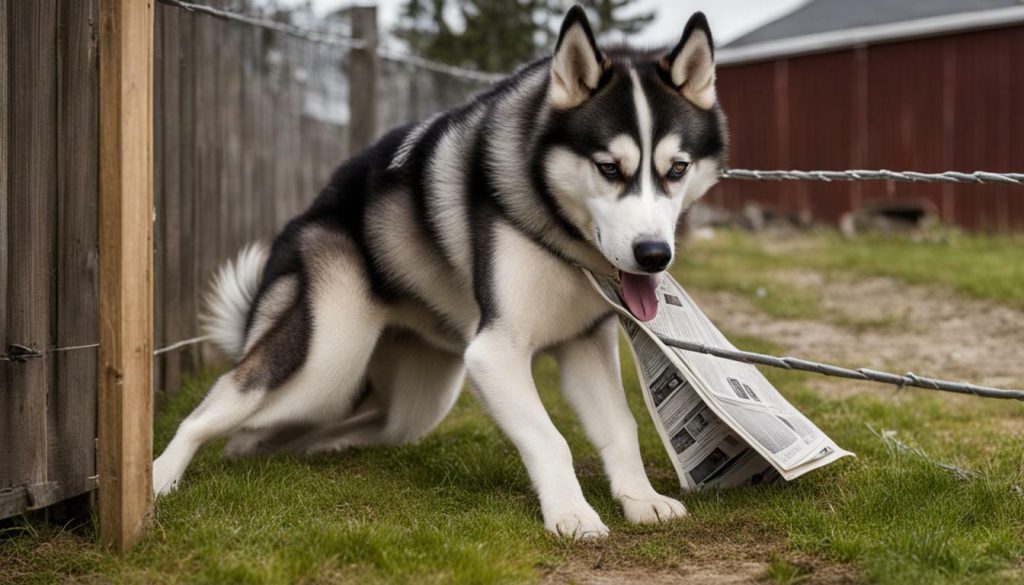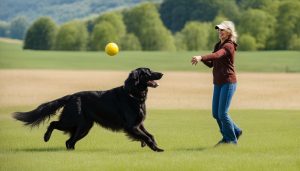Welcome to the world of Alaskan Husky dog training, where I will guide you through the secrets to unlock the full potential of your furry companion. Training Alaskan Huskies can be a rewarding journey, but it requires a deep understanding of their unique traits and needs. From their tendency to climb fences to their bursts of energy followed by rest periods, Alaskan Huskies present specific challenges that require tailored training techniques.
- Increasing fence height and changing fence type can help prevent Alaskan Huskies from climbing over.
- Exercise is crucial for Alaskan Huskies, so ensure they have plenty of physical and mental stimulation.
- Utilize the “nothing in life is for free” approach, where your dog must obey commands before receiving rewards.
- Positive reinforcement is the most effective training method for Alaskan Huskies.
- Establishing yourself as the alpha in the dog-human relationship is vital for successful training.
These key takeaways will serve as a foundation for effective Alaskan Husky dog training. With patience, consistency, and a strong bond with your Husky, you can unlock their full potential and enjoy a well-trained and happy companion.
Stay tuned for the upcoming sections where we will dive deeper into understanding the unique traits of Alaskan Huskies, explore effective training techniques, and learn about important aspects of their training journey.
Remember, every step you take in training your Alaskan Husky brings you closer to a fulfilling and harmonious relationship with your beloved pet.
Understanding the Unique Traits of Alaskan Huskies
Before diving into training techniques, it’s important to understand the distinctive traits and needs that make Alaskan Huskies stand out from other dog breeds. These beautiful and energetic dogs have a few characteristics that require special attention and care.
One challenge that Alaskan Husky owners often face is their tendency to climb fences. These dogs are agile and adventurous, so it’s important to take necessary precautions to prevent them from escaping. Increasing the height of the fence, changing the type of fence, or using a combination of a chain-link fence and an invisible/electronic fence can help keep them safely contained.
Exercise is crucial for Alaskan Huskies, as they have bursts of energy followed by rest periods. Regular exercise not only helps them burn off energy but also keeps them mentally stimulated. Engaging in activities like long walks, jogging, or participating in dog sports like agility can help meet their exercise needs.
| Traits | Needs |
|---|---|
| Agile and adventurous | Higher fences, exercise, mental stimulation |
| High energy bursts | Regular exercise, engaging activities |
Positive reinforcement is the most effective training method for Alaskan Huskies. They respond well to rewards and praise, so incorporating treats, toys, and verbal affirmation into their training encourages them to learn and obey commands.
Establishing yourself as the alpha
Establishing yourself as the alpha in your relationship with your Alaskan Husky is crucial for successful training. These dogs are pack-oriented and respond best to a confident and assertive leader. By being consistent, setting clear boundaries, and providing guidance, you can establish yourself as the pack leader and gain their respect and trust.
Alongside training, discipline, good nutrition, grooming, and socialization are important aspects of caring for an Alaskan Husky. Consistency and positive reinforcement are key in their training journey, and providing them with a structured routine helps them feel secure and confident.

- Discipline: Establishing rules and boundaries
- Good nutrition: Providing a balanced diet
- Grooming: Regular brushing and proper coat care
- Socialization: Exposing them to various environments, people, and animals
Working with a responsible breeder is essential to ensure that your Alaskan Husky puppy is well-socialized from an early age. This early socialization helps them develop into well-rounded and confident dogs. Crate training, establishing a schedule, and gradually introducing grooming and nail trimming are important in the early months.
In the first year, training milestones include obedience training, engagement in dog sports, and preventing escapes. As your Alaskan Husky grows, they can participate in longer-distance activities like sledding, carting, or biking, which provide them with both mental and physical stimulation.
Joining local Husky clubs is highly recommended for socializing your Alaskan Husky and participating in shared activities with other Husky owners. It not only benefits their social development but also provides you with a supportive community of fellow Husky enthusiasts.
Effective Training Techniques for Alaskan Huskies
Now that we have a solid understanding of Alaskan Husky traits, let’s explore some effective training techniques that will help you shape your Husky into a well-behaved companion. One challenge you may face is their tendency to climb fences. To prevent escapes, consider increasing the fence height or changing the fence type to make it more secure. Another option is to use a combination of a chain-link fence and an invisible/electronic fence system. This will help keep your Husky safely contained while still allowing them to enjoy the outdoors.
Physical and mental exercise is essential for Alaskan Huskies, as they have bursts of energy followed by rest periods. To keep them engaged and prevent boredom, incorporate daily exercise routines that include long walks, interactive play sessions, and activities like fetch or agility training. A tired Husky is more likely to be receptive to training and less likely to engage in destructive behaviors.
When it comes to training techniques, the “nothing in life is for free” approach works well with Alaskan Huskies. This means that your Husky should obey commands before receiving rewards, such as meals, treats, or access to their favorite toys. By reinforcing the idea that good behavior is rewarded, you can establish a clear hierarchy and reinforce your role as the alpha.
Positive reinforcement is the most effective method of training for Alaskan Huskies. Reward your dog with praise, treats, or playtime when they exhibit the desired behaviors. This will help your Husky associate obedience with positive outcomes and make the training process more enjoyable for both of you. Remember to be patient and consistent with your training efforts, as it may take some time for your Husky to fully grasp and respond to commands.
Table
| Training Tips | Techniques |
|---|---|
| Use positive reinforcement | Reward good behavior with treats, praise, or playtime |
| Establish yourself as the alpha | Observe the “nothing in life is for free” approach |
| Provide mental and physical exercise | Incorporate daily routines that challenge and engage your Husky |
| Prevent escapes | Increase fence height or use a combination of fences |

By following these effective training techniques, you can establish a strong bond with your Alaskan Husky and shape them into a well-behaved companion. Remember to be patient, consistent, and always use positive reinforcement. With time and dedication, your Husky will become a loyal and obedient member of your family.
Establishing Yourself as the Alpha
To ensure a harmonious training experience, it’s important to establish yourself as the alpha in your Alaskan Husky’s world. Huskies are pack animals by nature, and they instinctively look for a strong leader to follow. By asserting your role as the alpha, you establish trust, respect, and clear boundaries with your dog. This is crucial for effective training and maintaining a balanced relationship.
One way to establish yourself as the alpha is through consistent and fair leadership. Set clear rules and expectations for your Alaskan Husky and enforce them consistently. Be firm and confident in your commands, using a calm and assertive tone of voice. Remember to always reward good behavior and correct unwanted behaviors promptly and appropriately.
Another effective technique is to control valuable resources, such as food, toys, and attention. Make sure your Alaskan Husky understands that everything they want or enjoy comes from you. Before feeding, ask your Husky to perform a simple obedience command like “sit” or “stay.” This reinforces the concept of earning rewards through obedience and respect.
Positive reinforcement is essential in building a strong bond with your Alaskan Husky. Reward your dog with praise, treats, or playtime when they exhibit desired behaviors. This positive approach encourages your Husky to repeat those behaviors in the future. Remember to be patient and consistent in your training efforts, as establishing yourself as the alpha takes time and dedication.

| Establishing Yourself as the Alpha | Key Points |
|---|---|
| Consistent and fair leadership | Set clear rules and expectations, enforce consistently, reward good behavior, and correct unwanted behaviors. |
| Control valuable resources | Make sure your Alaskan Husky understands that everything they want or enjoy comes from you. |
| Positive reinforcement | Reward your dog with praise, treats, or playtime when they exhibit desired behaviors. |
Important Aspects of Alaskan Husky Training
Beyond basic training techniques, there are several key aspects to consider when training your Alaskan Husky to ensure their overall well-being and happiness. Discipline plays an important role in establishing boundaries and teaching your dog proper behavior. Consistency is key when implementing discipline, using firm but gentle methods to correct any unwanted behaviors. Remember to always reward good behavior and redirect your Husky’s attention when necessary.
Another crucial aspect of Alaskan Husky training is socialization. Huskies are naturally friendly and sociable dogs, but early socialization is important to ensure they are comfortable and well-behaved in various situations. Expose your Husky to different environments, people, and other animals from a young age, gradually increasing the intensity of the socialization experiences. This will help them develop into confident and well-adjusted dogs.
Grooming is also a significant aspect of training for Alaskan Huskies. Regular grooming sessions will keep their coat clean, healthy, and free from tangles. Brush your Husky’s fur regularly to prevent matting and promote healthy hair growth. Additionally, trim their nails regularly to avoid discomfort or injury. It’s important to introduce grooming slowly and positively, making it a pleasant experience for your Husky.

To summarize, when training your Alaskan Husky, remember to focus on discipline, socialization, and grooming. Consistency, positive reinforcement, and establishing yourself as the alpha are crucial in their training journey. By addressing these important aspects, you can ensure your Alaskan Husky is well-behaved, healthy, and happy.
| Training Aspects | Key Points |
|---|---|
| Discipline | – Implement firm and gentle methods – Consistency is key – Reward good behavior |
| Socialization | – Expose to different environments, people, and animals – Gradually increase socialization experiences – Develops confidence and adaptability |
| Grooming | – Regular brushing to prevent matting – Trim nails regularly – Introduce grooming positively |
The Importance of Responsible Breeding and Early Training
The early stages of your Alaskan Husky’s life are crucial for setting a solid foundation through responsible breeding and early training. Working with a responsible breeder is essential to ensure that your puppy is properly socialized and has a good temperament. A well-bred Alaskan Husky will have a better chance of being a well-rounded and trainable companion.
Responsible breeders carefully select breeding pairs based on health, temperament, and working ability. They prioritize the overall well-being of the breed and ensure that their dogs are free from genetic disorders. By choosing a responsible breeder, you are supporting the preservation and improvement of the Alaskan Husky breed.
Early training is also crucial for your Alaskan Husky’s development. Establishing a routine from an early age will help your puppy adapt to a structured lifestyle. Crate training is often recommended to help with potty training and to provide a safe and secure space for your puppy. Gradually introducing grooming practices, such as nail trimming and brushing, will help your puppy become accustomed to these essential tasks.
Positive reinforcement training methods are highly effective with Alaskan Huskies. Reward-based training, where your dog obeys commands in order to receive rewards like treats or praises, will motivate and encourage them to learn. Consistency and patience are key during this training process. It’s important to remember that all dogs, including Alaskan Huskies, thrive when they have a strong bond with their owner based on trust and respect.

Training Milestones in the First Year
As your Alaskan Husky grows, you’ll encounter various training milestones that will shape their behavior and abilities. Obedience training plays a crucial role in establishing a strong foundation for your dog’s training journey. Teaching basic commands such as sit, stay, and come should be the first step. Utilize positive reinforcement techniques, such as treats and praise, to encourage your Husky’s cooperation.
Basic command milestones:
- By 3 months old, your Husky should be able to respond consistently to their name and understand basic commands like sit and come.
- By 6 months old, they should master more advanced commands like stay and heel.
- By 9 months old, your Husky should have a solid grasp of basic obedience commands and be ready to progress to more advanced training.
In addition to obedience training, engaging in dog sports is an excellent way to challenge your Alaskan Husky both mentally and physically. These activities provide an outlet for their high energy levels and help prevent behavioral issues that may arise from boredom.
When participating in dog sports, it’s important to prioritize safety and prevent escapes. Alaskan Huskies are known for their wandering nature, so ensuring a secure environment is key. This can be achieved by reinforcing boundaries, using double fencing, or utilizing a combination of a chain-link fence and an invisible/electronic fence. Remember to always supervise your Husky during outdoor activities to prevent any potential mishaps.

By focusing on these training milestones, you can raise a well-behaved and happy Alaskan Husky. Remember to be patient, consistent, and firm in your training approach. With time and effort, your furry companion will become a proud and obedient member of your family.
Advanced Training and Long-Distance Activities
Once your Alaskan Husky reaches maturity, you can introduce them to more advanced training techniques and engage in exciting long-distance activities. Agility training is a great way to challenge your Husky both mentally and physically. Set up obstacle courses with hurdles, tunnels, and weave poles to enhance their coordination and dexterity. This type of training helps them build confidence and strengthens the bond between you and your furry companion. Remember to start with basic commands and gradually increase the difficulty level as your Husky becomes more proficient.
Another option for advanced training is enrolling in Alaskan Husky training classes. These classes provide structured training sessions led by experienced instructors. They focus on specific skills such as off-leash obedience, recall, and advanced tricks. Training classes also offer an opportunity for your Husky to socialize with other dogs, promoting good behavior and canine communication.
In addition to training, long-distance activities can provide the necessary exercise and mental stimulation for your Alaskan Husky. Sledding, carting, and biking are popular choices for these energetic dogs. However, it’s essential to ensure their safety during these activities. Use appropriate equipment, such as sleds or carts designed for Husky breeds, and always supervise them during the entire exercise session.
Including a variety of activities in your Husky’s routine will prevent boredom and help them stay happy and healthy. Remember to provide regular mental and physical stimulation to channel their energy in a positive way. With proper training and engaging long-distance activities, your Alaskan Husky will thrive and enjoy a fulfilling life as your loyal companion.
Table: Recommended Long-Distance Activities for Alaskan Huskies
| Activity | Description |
|---|---|
| Sledding | Let your Husky pull a sled in snowy conditions, emulating their natural instinct to run and pull. This activity is not only physically demanding but also mentally stimulating for your Husky. |
| Carting | Attach your Husky to a cart and let them pull it while you provide guidance. This activity is suitable for both on-road and off-road environments, providing an excellent workout for your Husky. |
| Biking | Take your Husky on a bike ride by attaching them to a specially designed biking attachment. This activity allows them to run alongside you, providing a thrilling and challenging experience. |
In summary, advanced training techniques and long-distance activities are a fantastic way to further develop your Alaskan Husky’s skills and provide the necessary exercise they require. Agility training, Alaskan Husky training classes, sledding, carting, and biking are all excellent options to keep your Husky mentally and physically stimulated. Remember to start with basic commands and gradually increase the difficulty level, ensuring the safety of your Husky during long-distance activities. Incorporate a mix of these activities into your Husky’s routine for a happy, well-rounded companion.
The Benefits of Joining Local Husky Clubs
To enhance your Alaskan Husky’s socialization and create a strong support network, consider joining local Husky clubs in your area. These clubs provide a range of benefits for both you and your furry companion. From organized activities to educational resources, you’ll find everything you need to ensure your Husky has a happy and fulfilling life.
Local Husky clubs offer numerous opportunities for socialization, allowing your dog to interact with other Huskies in a controlled environment. This is especially important for Huskies, as they are known for their pack mentality and thrive on social interactions. Through group walks, playdates, and events, your Husky will develop essential social skills and build positive relationships with other dogs.
In addition to socialization, joining a local Husky club provides access to a supportive community of fellow Husky owners. These clubs often organize meetups, seminars, and workshops where members can share their experiences, exchange training tips, and seek advice from seasoned Husky owners. This sense of camaraderie and shared knowledge can be invaluable on your journey as a Husky owner.
Furthermore, local Husky clubs often collaborate with experts in the field to offer educational resources and training opportunities. From obedience classes to agility training, you’ll find a variety of programs tailored specifically to Alaskan Huskies. These activities not only help improve your dog’s physical fitness and mental stimulation but also strengthen the bond between you and your Husky.

| Benefits of Joining Local Husky Clubs: |
|---|
| Opportunities for socialization |
| Supportive community of fellow Husky owners |
| Access to educational resources and training programs |
| Improved physical fitness and mental stimulation for your Husky |
| Stronger bond between you and your Husky |
Conclusion
Congratulations on completing this comprehensive guide to Alaskan Husky dog training. By applying the tips and techniques shared, you’re on your way to having a better behaved and happier Alaskan Husky.
Mastering the training of Alaskan Husky dogs requires understanding their unique traits and needs. One challenge is their tendency to climb fences, so it’s recommended to increase fence height, change fence type, or use a combination of a chain-link fence and an invisible/electronic fence. Exercise is essential for Huskies, as they have bursts of energy followed by rest periods.
Training should include the “nothing in life is for free” approach, where the dog must obey commands before receiving rewards. Positive reinforcement is the most effective training method, and establishing yourself as the alpha is crucial. Additionally, discipline, good nutrition, grooming, and socialization are important aspects of training.
Working with a responsible breeder is essential to ensure the puppy is properly socialized. Crate training, establishing a schedule, and gradually introducing grooming and nail trimming are important in the early months. Obedience training, engaging in dog sports, and preventing escapes are goals during the first year. Finally, at around one year of age, Huskies can participate in longer-distance activities like sledding, carting, or biking. Joining local Husky clubs is recommended for socializing and shared activities.
FAQ
How can I prevent my Alaskan Husky from climbing fences?
To prevent climbing, you can increase the height of your fence, change the type of fence, or use a combination of a chain-link fence and an invisible/electronic fence.
What is the “nothing in life is for free” approach in training Alaskan Huskies?
The “nothing in life is for free” approach means that your Husky must obey commands before receiving rewards, such as food, attention, or toys. This helps establish your leadership and reinforces positive behavior.
What is the most effective training method for Alaskan Huskies?
Positive reinforcement, which involves rewarding desired behaviors, is the most effective training method for Alaskan Huskies. This can include treats, praise, or playtime.
Why is it important to establish yourself as the alpha in Alaskan Husky training?
Establishing yourself as the alpha in the dog-human relationship is crucial for successful training. It helps your Husky understand their place in the hierarchy and promotes obedience and respect.
What are the important aspects of Alaskan Husky training?
Discipline, good nutrition, grooming, and socialization are important aspects of Alaskan Husky training. Consistency in training and creating a structured routine are also key.
How can I ensure my Alaskan Husky puppy is properly socialized?
Working with a responsible breeder is essential to ensure proper socialization. They should expose the puppy to various environments, people, and other animals from a young age.
What training milestones should I focus on during the first year?
During the first year, important training milestones include obedience training, engaging in dog sports, and preventing escapes. These milestones help establish good behavior and a strong bond with your Husky.
What advanced training and long-distance activities can I do with my adult Alaskan Husky?
Once your Alaskan Husky reaches around one year of age, you can participate in activities like sledding, carting, biking, or agility training. These activities provide mental and physical stimulation.
What are the benefits of joining local Husky clubs?
Joining local Husky clubs allows for socialization opportunities for your Husky and yourself. It also provides a supportive community of fellow Husky owners who can share advice, tips, and engage in group activities.
Source Links
- https://www.akc.org/expert-advice/training/how-to-train-a-siberian-husky/
- https://foreverhusky.org/2022/02/02/revealedsecret-training-methods-for-the-siberian/
- https://www.siberianhuskyrescue.org/training-tips/








 Welcome to my dog blog, where I can finally express my unwavering love for our canine companions. I'm Jenniffer, a passionate advocate for dogs and a firm believer that they make our lives infinitely better. Join me as I share my personal experiences, insights, and tips on creating a harmonious bond with these incredible creatures. Let's embark on this journey together, celebrating the joy and companionship that dogs bring to our lives.
Welcome to my dog blog, where I can finally express my unwavering love for our canine companions. I'm Jenniffer, a passionate advocate for dogs and a firm believer that they make our lives infinitely better. Join me as I share my personal experiences, insights, and tips on creating a harmonious bond with these incredible creatures. Let's embark on this journey together, celebrating the joy and companionship that dogs bring to our lives.